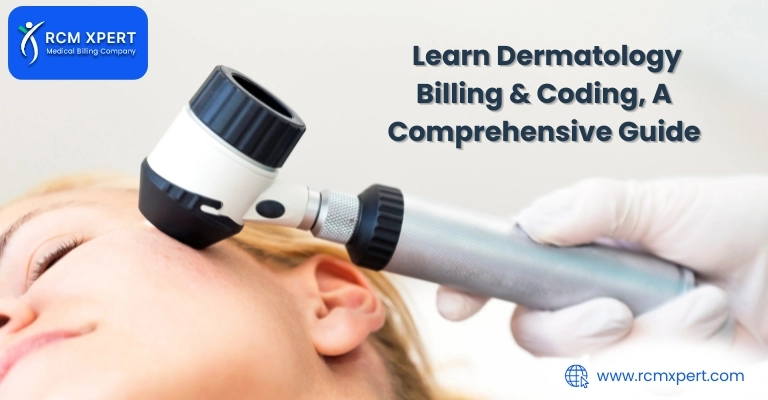Dermatology medical billing and coding involves the translation of healthcare services, including diagnoses, treatments, and procedures, into standardized codes. These codes are then used for billing insurance companies and patients. In dermatology, this process encompasses a wide range of services, from routine skin examinations to surgical procedures.
The complexity of dermatological services, combined with the complexities of coding systems such as the International Classification of Diseases (ICD-10) and the Common Procedural Terminology (CPT), requires specialized knowledge and skills.
This blog on dermatology medical billing and coding offers an overview of its fundamentals and underscores the importance of accuracy in this complex process.
Understanding Dermatology Billing and Coding
In the complex world of healthcare, dermatology medical billing and coding stand out as critical functions that ensure dermatologists and their practices are compensated accurately for the services they provide. This section offers insights into the complexities of billing and coding specifically tailored for the field of dermatology.
Dermatology Medical Billing and Coding:
The importance of dermatology medical billing, and coding involves the translation of procedures, treatments, and diagnoses into universally recognized codes. This process not only facilitates accurate billing but also ensures compliance with insurance regulations. Utilizing the focus keyword “dermatology medical billing and coding,” it’s essential to recognize that precise coding directly impacts reimbursement rates and legal compliance, underscoring the need for ongoing education and vigilance in code application.
10 Dermatology Codes
Among the crowd of codes, ten dermatology codes frequently enclose common procedures and diagnoses in the specialty.
Below are examples of these codes, highlighting their specificity and importance in dermatology:
L30.0 – Atopic dermatitis
L40.0 – Psoriasis vulgaris
L60.0 – Ingrown nail
L70.0 – Acne vulgaris
L72.0 – Epidermal cyst
L90.0 – Scar conditions and fibrosis of the skin
L98.0 – Pyogenic granuloma
C43.0 – Malignant melanoma of the lip
C44.9 – Malignant neoplasm of skin, unspecified
D23.0 – Other benign neoplasms of skin
Dermatology Coding:
The complexities of dermatology coding cannot be understated, with a requirement for detailed knowledge of the differences between procedures that may appear similar but are billed differently. For example, the distinction in coding for a simple versus a complex excision of a lesion can significantly affect reimbursement. Mastery over “dermatology coding” involves not only understanding the current codes but also staying informed about changes and updates to coding practices.
Key Dermatology Codes:
This section explores the key dermatology codes, focusing on the Common Procedural Terminology (CPT) codes, the International Classification of Diseases (ICD-10) codes used in dermatology, and strategies for staying abreast of coding updates.
Here’s a concise table summarizing common dermatology coding using both ICD-10 and CPT codes for various conditions and procedures:
| Condition/Procedure | ICD-10 Code | CPT Code | Description |
| Malignant Melanoma of the Skin | C43 | Varies | Coding for skin cancer involving melanoma. |
| Other Skin Cancers | C44 | Varies | Coding for non-melanoma skin cancers. |
| Atopic Dermatitis | L20 | Varies | Coding for eczema or atopic dermatitis. |
| Acne Vulgaris Psoriasis | L20 L40 | Varies Varies | Coding for Common Acne.Coding for psoriasis conditions |
| Skin Biopsy | Varies | 11102-11107 | Coding for biopsy procedures on the skin |
| Excision of Benign Lesions | Varies | 11400-11446 | Coding for excision of benign skin lesions. |
| Excision of Malignant Lesions | Varies | 11600-11646 | Coding for excision of malignant skin lesions. |
| Destruction of Benign Lesions | Varies | 17110-17111 | Coding for destruction of benign lesions. |
| Destruction of Malignant Lesions | Varies | 17250-17286 | Coding for destruction of malignant lesions. |
| Laser Therapy | Varies | 17106-17108, 17270-17273 | Coding for laser treatment procedures. |
| Photodynamic Therapy | Varies | 96567, 96900 | Coding for photodynamic therapy procedures. |
How to Stay Updated with the Latest Coding Changes and Updates
The field of medical billing and coding is continually changing, with regular updates to both CPT and ICD-10 codes. Dermatology practices can stay current by subscribing to updates from the American Medical Association (AMA) and the World Health Organization (WHO), attending coding seminars and workshops, and utilizing coding software tools that are regularly updated. Ensuring access to the latest codes and billing practices is instrumental in optimizing billing processes and improving the financial health of dermatology practices.
Documentation Best Practices
Thorough documentation in dermatology not only facilitates accurate medical billing and coding but also ensures compliance with healthcare regulations.
Importance of Thorough Documentation in Dermatology Procedures
Effective documentation is paramount for capturing the full scope of dermatological services, from diagnosis to treatment. It aids in justifying the medical necessity of procedures to insurance providers, thereby supporting coverage claims. Detailed notes, including visual documentation when possible, can significantly enhance the clarity and completeness of patient records.
Tips for Documenting Common Dermatological Procedures and Visits
Here are some common tips that can help healthcare providers, medical billers, and practice managers enhance their documentation practices:
Use Specific and Detailed Descriptions: Clearly describe the condition being treated, including the size, location, and appearance of any lesions or affected areas. For instance, instead of “mole removed,” specify “5 mm raised, pigmented nevus on the right lower forearm excised.”
Document Every Step: Record all steps taken during the procedure, including preparation, the procedure itself, and any post-procedure care. This should also include the method used for the procedure (e.g., punch biopsy, laser therapy) and the exact amount of any materials used (e.g., 2 ml of local anesthetic).
Include Patient Symptoms and History: Document the patient’s symptoms and any relevant history that justifies the procedure’s necessity. This information is crucial for insurance companies to understand the medical necessity behind each service provided.
Record Post-Procedure Instructions and Follow-up Care: Document any care instructions given to the patient post-procedure, including medications prescribed, wound care instructions, and any follow-up visit recommendations. This demonstrates a continuum of care that is often required for reimbursement.
Utilize Proper Coding: Accurately code the diagnosis (ICD-10 codes) and the procedure (CPT codes) performed. For instance, use specific diagnosis codes like L70.0 for Acne vulgaris or C44.9 for unspecified malignant neoplasm of skin, paired with the appropriate procedure codes.
Adhere to Compliance Standards: Ensure your documentation complies with HIPAA and other regulatory standards. This includes maintaining patient confidentiality and ensuring all records are complete and accurately reflect the care provided.
Leverage Technology: Utilize Electronic Health Records (EHR) systems to their full potential. These systems often have templates and tools designed to streamline the documentation process, ensuring that all necessary information is captured efficiently and accurately.
Continuous Education: Stay informed about the latest coding updates and guidelines. Regular training sessions for staff on the latest dermatology coding and billing practices can greatly reduce errors and improve the accuracy of claims.
Common Dermatology Billing and Coding Errors
Mistakes in dermatology billing and coding not only disrupt the revenue cycle but also risk non-compliance with healthcare regulations. By identifying common errors, practices can streamline their operations and ensure financial stability.
- Typical Mistakes in Dermatology Billing and Coding
Common errors include incorrect use of diagnosis codes, such as ICD-10 codes for skin checks or acne treatment, and procedural codes, like dermatologist CPT codes. Misidentifying a procedure or misapplying a diagnosis code can lead to claim rejections or denials. Another frequent mistake is failing to update codes to reflect the latest revisions, resulting in outdated or inaccurate billing.
- How These Errors Affect Reimbursements and Compliance
Inaccurate coding directly impacts a practice’s bottom line through denied claims or delayed payments, requiring additional resources to address and correct issues. Furthermore, persistent coding errors can trigger audits, leading to potential legal and financial penalties for non-compliance.
- Strategies to avoid common errors: To avoid common dermatology billing and coding errors, which can significantly impact practice revenues and compliance, consider implementing these strategic measures:
Regular Training and Education: Keep your billing and coding team up-to-date with the latest ICD-10 and CPT codes, including any changes to dermatology coding guidelines. Regular workshops or online courses can be beneficial.
Utilize Advanced Software: Implementing advanced Electronic Health Record (EHR) and billing software that automatically updates coding changes and checks for errors can drastically reduce mistakes.
Internal Audits: Conduct regular audits of your billing and coding processes to identify and correct errors proactively. This can help catch discrepancies before they lead to denied claims or compliance issues.
Clear Communication Among Staff: Encourage a culture of open communication between dermatologists, medical billers, coders, and practice managers. This ensures that any ambiguities in documentation are clarified promptly, leading to accurate coding.
Accurate Documentation: Stress the importance of thorough and precise documentation by healthcare providers. Detailed records support the medical necessity of treatments, facilitating appropriate coding and billing.
Stay Informed About Insurance Policies: Understanding what dermatology procedures are covered by insurance and any policy changes is crucial. This knowledge helps in accurate billing and informing patients about their coverage.
Use of Checklists: Develop checklists for common procedures and visits that include all necessary documentation and coding steps. This can serve as a quick reference for staff to ensure no steps are missed.
Outsourcing to Specialists: Consider outsourcing your medical billing and coding to firms specializing in dermatology. This can reduce the burden on your practice and leverage the expertise of specialists familiar with dermatology-specific coding challenges.
Feedback Loop: Create a system for feedback on denied claims to learn from errors. Analyzing denials for patterns can help identify areas for improvement in coding practices.
Provider Engagement: Engage dermatologists in the coding process by providing them with concise coding updates relevant to their practice. This encourages accurate documentation from the start.
Conclusion
Overall, exploring dermatology medical billing and coding is crucial for the financial and operational success of dermatology practices. By staying informed about coding updates, ensuring accurate documentation, and implementing checks for common errors, practices can avoid claim denials and enhance revenue. Continuous education and the use of advanced technology play pivotal roles in navigating the complexities of dermatology billing. Ultimately, precision in coding and billing not only supports compliance but also ensures that dermatologists are compensated appropriately for their essential services.














